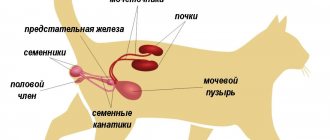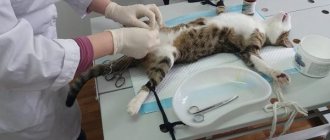A cat that lives at home periodically “delights” its owners with loud, heart-rending screams, signaling the onset of mating season. With its behavior at this time, any, even the best cat in the world is capable of wearing out the entire nervous system of the household. There is a solution to this problem that will save the owner from the animal’s inappropriate behavior and its consequences - this is cat castration.
Castration is a surgical or non-surgical intervention in a male’s body to remove the gonads. The procedure has both advantages and disadvantages, because in any case it will affect the future quality of life of both the cat and its owners.
Pros and cons of castration
global $ads_google; //data-ad-slot=”2475549904″ $ads_google = empty($ads_google) ? false : true; ?> if ($ads_google == false) {?>
$ads_google = true; ?> } ?>
Often the reason for castration of a cat is not only his urgent demand to continue his family, but also an active desire to mark territory. To prevent the furry friend from causing such problems, an operation is performed.
This leads to obvious advantages of the procedure:
- there is no reason to mark territory;
- no excessive aggression;
- absence of loud demands from the cat;
- reducing the risk of genitourinary diseases;
- increasing lifespan.
We must not forget about the disadvantages :
- It is possible that a cat with loss of gonads acquires an increased appetite. This can lead to obesity and health problems;
- perhaps due to changes in hormonal balance, a decrease in the activity of the animal, which is also fraught with obesity;
- when performing surgery on adults or elderly males, sometimes difficulties arise with the functioning of the cardiovascular system;
- if castration was carried out at the wrong time, then not only the testes, but also the pituitary gland take over the production of sex hormones: the operation becomes useless, and all the “cute” manifestations of the mating season continue.
But if the animal is healthy, the cat is castrated at the appropriate time, and the owners strictly monitor the pet’s balanced diet, the disadvantages do not manifest themselves.
Is it worth doing?
Pros:
- Change in behavior, lack of aggression;
- The cat stops marking his territory. Even if the instinct persists for some time after the operation (this is possible with late castration), the smell of urine becomes less pungent;
- The animal will not strive to leave its home - the risk that the cat will run away for a walk is reduced;
- The risk of developing malignant genital diseases is reduced several times.
Consequences (cons):
- The risk of the operation itself, performed under general anesthesia. To reduce it, do not neglect preparatory measures, carefully choose a clinic and veterinarian. Do not forget about a preliminary consultation with a veterinarian, choose modern anesthesia and procedure techniques.
- Risk of postoperative wound infection. Follow all doctor's recommendations, treat the wound, and prevent scratching and licking. If infected, contact your doctor immediately for treatment.
- Risk of pet obesity. After surgery, provide your cat with more active physical activity. Pay enough attention to your diet - reduce the serving size. After consulting with a veterinarian, switch the cat to specialized food for castrates.
When to castrate a cat
To answer the question about the appropriate time for castration, you need to understand when the organs and systems of the body complete their formation.
This happens at about one year, but physiologically the cat becomes sexually mature at six months. Therefore, 6 months is the earliest time to castrate a cat.
.
If the operation is performed before six months, then there is a high probability that the cat will develop urolithiasis (this is especially true for Persians, Himalayan cats, British cats and Scottish Fold breeds), because the urethra is not fully formed. The testes of some males at this age may still not be in place, and this is a significant problem for surgical castration.
You don’t have to wait long: the procedure performed at the age of 7-9 months is easier and more successful.
In any case, a preliminary consultation at a veterinary clinic is required.
General facts
Castration is considered not such a simple operation as many assume. This is not just the removal of the testes: during the operation, the glands of the genital organs are cut and the reproductive functions of the body are completely stopped. The procedure can be carried out using several methods:
- Standard excision. This technique is the most common and simple.
- Fertility with the help of medications. For this, an implant is sewn under the skin with the required amount of medication that suppresses the cat’s sexual desire. This is an expensive but safe procedure.
- Chemical sterilization, during which a mixture of drugs is injected directly into the testes. This compound destroys the glands. Their tissue is then replaced by muscle tissue. This procedure, which has not taken root in our country, is considered easy to use and cheap.
- Castration under the influence of radiation. The organ is placed under gamma rays and treated. Such manipulation requires quite expensive equipment. From a safety point of view, this is a simple intervention that does not require anesthesia.
It is clear that surgical penetration into the animal's body is not always necessary. However, it is excision with a scalpel that is popular in domestic veterinary practice. Most likely, this is due to the low cost of the method.
Types of castration
Surgical and non-surgical methods are used.
Surgical methods:
- Open method - the scrotum is greatly stretched and an incision is made. The testis is removed, the vaginal membrane is freed from it using scissors. The spermatic cord is removed and tied to itself. The same is done with the second testis, after which they are removed.
- With the closed method, the tunica vaginalis is not opened, but only an incision is made to remove the testis and the tunica vaginalis from the scrotum. A ligature is applied to the spermatic cord and cut off. The skin of the scrotum is not sutured.
- The bloodless method or castration without removing the testicles consists of squeezing the spermatic cords with special forceps, after which, after 5 months, they are reabsorbed.
- Vasectomy is a gentle method of sterilization: the seminiferous tubules are partially destroyed, which serves as an obstacle to sperm entering the penis. The testes continue their work, and the cat continues to demand a female, but cannot continue the race.
Non-surgical methods do not involve removing the testicles. This includes chemical castration in the form of injections, tablets or the introduction of a Suprelorin implant.
Preparing a cat for castration
Careful preparation of the animal is mandatory: the success of the operation largely depends on this. If you ignore the veterinarian’s instructions, you may experience health complications and, as a result, additional financial losses.
It is important to follow a strict diet, as anesthesia can cause a gag reflex. The male is not fed for 10-12 hours before the start of the procedure, which will prevent vomit from entering the respiratory tract. Water is not given 4-6 hours before surgery.
global $ads_google; //data-ad-slot=”2475549904″ $ads_google = empty($ads_google) ? false : true; ?> if ($ads_google == false) {?>
$ads_google = true; ?> } ?>
The cat should not have any diseases or health problems that could be a contraindication to castration.
A week before the operation, the cat is dewormed, and the day before it is washed with zoo shampoo.
Consequences
Castration of cats is considered an easy operation; after it, dangerous consequences and complications rarely arise. But no veterinarian can guarantee with maximum accuracy that this surgical intervention will go smoothly. It all depends on the individual characteristics of the animal’s body and on the implementation of important recommendations in the postoperative period.
Cats may exhibit the following physiological disorders:
- internal bleeding. This complication occurs very rarely, but still sometimes occurs. Usually during this procedure the cat is in a lethargic and passive state after surgery. If you want to pick him up or stroke him, this will cause him severe pain. Pay attention to the appearance of the oral mucosa; if it is pale, contact your veterinarian immediately;
- the presence of infection in the wound area. Typically, for the first 3-4 days after surgery, there may be redness and swelling in the area around the incision site. If the inflammatory process intensifies, this indicates that an infection has entered the wound area; be sure to visit a veterinarian;
- obesity. Usually, anesthesia causes hormonal imbalance and slows down metabolism. After the operation, the condition returns to normal. But sometimes it can get worse and cause weight gain. In these cases, you should consult a veterinarian. He will recommend the right treatment.
- constipation, in the first days after castration.
Find out more about the indications and contraindications for cat castration surgery>>>
Castrate a cat at home
Like spaying a cat, neutering can be done at home.
The arriving veterinarian does an examination and, in case of problems, gives answers to all questions. If there are no contraindications, the cat is given anesthesia. After it comes into force, the operation begins and lasts up to 20 minutes.
Then the animal comes out of anesthesia, and the veterinarian once again advises the owners about possible difficulties and gives recommendations for caring for the cat after the operation.
Conclusions:
Early castration of kittens is a convenient way to control the reproduction of cats and helps reduce the number of unwanted and neglected animals.
At the current level of development of veterinary medicine, early castration does not pose a greater danger to the pet’s body than an operation performed later.
The risk of long-term negative consequences of early castration for the health of the animal is no different from what accompanies this operation at an older age. At the same time, early castration is a reliable means of preventing certain diseases.
Numerous studies and extensive experience from North American shelters show that early neutering does not have a negative impact on the physical development and behavior of a cat.
Many factors influence a cat's behavior. Neutering can help eliminate some of the behavioral problems, but after castration, animals need the same attention from their owners and proper training as before.
Caring for a cat after castration
How long does it take for a cat to recover from anesthesia? Depends on what kind of drug was used. In any case, you need to monitor the cat’s behavior after castration : the animal will experience stress, so you will definitely need to show it affection and attention. A cat who is restless after neutering will feel more confident if the owner holds him on his lap, pets him and talks to him.
After the anesthesia wears off, the cat can sleep for several hours. The awakened animal is usually weakened and disoriented. If a cat shows aggression against this background, then it is quite capable of causing injury to itself and its owner. It is important to be nearby at this moment and calm the pet. This behavior may be associated with dizziness and nausea.
Anesthesia has a depressing effect on thermoregulation processes in the body, so the operated cat is placed in a warm place away from drafts.
Immediately after the pet gets up, it will rush to look for water, so the bowl with it should stand next to the rookery.
The toilet should be within the animal's access area after anesthesia.
If during the operation the cat was not given saline solution or an “artificial tear” drug, then dryness on the cornea will be eliminated by lacrimation.
The wound will need to be treated: if dirt appears, they are removed with a damp cotton pad and treated with an antiseptic. It would be better to put an Elizabethan collar on the cat's neck - it will not allow the animal to damage the seams. After 4-5 days the device is no longer required.
In just a few days the cat will return to normal and recover.
Feeding castrated cats
After castration, very little time should pass, the pet’s body will be rebuilt, and the character of the furry friend will become softer. He will be less and less drawn to street walks, but his appetite may increase noticeably.
To prevent a once powerful healthy cat from turning into a fluffy dumpling of particularly large sizes, it will be necessary to reduce the total calorie intake by 25-30%.
Food for neutered cats does not include fish dishes, and it is better to avoid dry non-specialized food altogether. Fried, salty, fatty foods are not recommended.
An excellent healthy food would be porridge and boiled lean meat. There is a ready-made balanced food for neutered cats.
If a cat marks after castration
global $ads_google; //data-ad-slot=”2475549904″ $ads_google = empty($ads_google) ? false : true; ?> if ($ads_google == false) {?>
$ads_google = true; ?> } ?>
This question arises periodically, and there is only one recommendation: find the reason for the tagging.
In the event of such an incident, the animal is brought for examination to a specialist, since the examination may reveal a poorly performed operation, or the cat turned out to be cryptorchid and its testicles are not in the abdominal cavity.
The solution to the problem may be a repeat operation - the testes need to be removed, as they produce sex hormones.
Another reason for leaving an unpleasant smell in the apartment from marks is the cat’s banal bad manners; here you will need to study tips on how to wean a cat from marking its territory.
There are animal psychologists who can help desperate owners cope with their cat’s desire to mark.
How much does it cost to cast a cat?
Each veterinary clinic sets its own prices for surgical or non-surgical intervention in the animal’s body for the purpose of castration.
The average price for castration of cats is 2,000 rubles, but this amount does not always include anesthesia, examination-consultation, hospital, and post-operative care. Accordingly, the price increases depending on the clinic.
Castrating a cryptorchid cat will be more expensive: cats with testes in the subcutaneous tissue cost about 2500-3500 rubles, and if the testes are located in the abdominal cavity, 3100-4500 rubles.
Take care of the health of your cats, and they will remain your faithful friends for many years.











